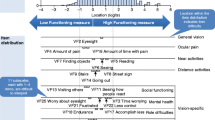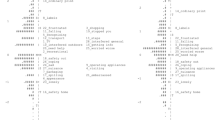Abstract
Purpose
Preference-based health measures value how people feel about the desirability of a health state. Generic measures may not effectively capture the impact of vision loss from ocular diseases. Disease-targeted measures could address this limitation. This study developed a vision-targeted health state classification system based on the National Eye Institute Visual Function Questionnaire-25 (NEI VFQ-25).
Methods
Secondary analysis of NEI VFQ-25 data from studies of patients with central (n = 932)- and peripheral-vision loss (n = 2,451) were used to develop a health state classification system. Classical test theory and Rasch analyses were used to identify a smaller set of NEI VFQ-25 items suitable for the central- and peripheral-vision-loss groups.
Results
Rasch analysis of the NEI VFQ-25 items using the peripheral vision–loss data indicated that 11 items fit a unidimensional model, while 14 NEI VFQ-25 items fit using the central-vision-loss data. Combining peripheral-vision-loss data and central-vision-loss data resulted in 9 items fitting a unidimensional model. Six items covering near vision, distance vision, social vision, role difficulties, vision dependency, and vision-related mental health were selected for the health-state classification.
Conclusions
The derived health-state classification system covers relevant domains of vision-related functioning and well-being.
Similar content being viewed by others
Abbreviations
- AMD:
-
Age-related macular degeneration
- DIF:
-
Differential item functioning
- EQ-5D:
-
EuroQol
- HRQL:
-
Health-related quality of life
- HUI:
-
Health utility index
- NEI VFQ-25:
-
National eye institute visual function questionnaire-25
- NICE:
-
National institute of health and clinical excellence
- QALY:
-
Quality-adjusted life year
- QWB-SA:
-
Quality of well-being, self-administered
- SF-12:
-
The 12-item short form health survey
- SF-36:
-
Medical outcome short form (32) health survey
- VFQ-UI:
-
Visual function questionnaire—utility index
References
Gold, M. R., Siegel, J. E., Russell, L. B., & Weinstein, M. C. (Eds.). (1996). Cost-effectiveness in health and medicine. New York: Oxford University Press.
Fryback, D. G., Dunham, N. C., Palta, M., Hanmer, J., Buechner, J., Cherepanov, D., et al. (2007). US norms for six generic health-related quality-of-life indexes from the national health measurement study. Medical Care, 45(12), 1162–1170.
Gold, M. R., Stevenson, D., & Fryback, D. G. (2002). HALYS and QALYS and DALYS, Oh My: Similarities and differences in summary measures of population health. Annual Review of Public Health, 23, 115–134.
Kaplan, R. M. (2005). Measuring quality of life for policy analysis: Past, present and the future. In W. R. Lenderking & D. A. Revicki (Eds.), Advancing health outcomes research methods and clinical applications. McClean, VA: International Society for Quality of Life Research.
Lipscomb, J., Drummond, M., Fryback, D., Gold, M., & Revicki, D. (2009). Retaining, and enhancing, the QALY. Value Health, 12(Suppl 1), S18–S26.
Weinstein, M. C., Torrance, G., & McGuire, A. (2009). QALYs: The basics. Value Health, 12(Suppl 1), S5–S9.
Brazier, J., Czoski-Murray, C., Roberts, J., Brown, M., Symonds, T., & Kelleher, C. (2008). Estimation of a preference-based index from a condition-specific measure: The King’s health questionnaire. Medical Decision Making, 28(1), 113–126.
Torrance, G. W. (1986). Measurement of health state utilities for economic appraisal. Journal of Health Economics, 5(1), 1–30.
Feeny, D., Furlong, W., Torrance, G. W., Goldsmith, C. H., Zhu, Z., DePauw, S., et al. (2002). Multiattribute and single-attribute utility functions for the health utilities index mark 3 system. Medical Care, 40(2), 113–128.
Feeny, D., Torrance, G. W., & Furlong, W. (1996). Health utilities index. In B. Spilker (Ed.), Quality of life and pharmacoeconomics in clinical trials. Philadelphia, PA: Lippincott-Raven Press.
The EuroQol Group. (1990). EuroQol–a new facility for the measurement of health-related quality of life. Health Policy, 16(3), 199–208.
Brooks, R., Rabin, R., & de Charro, F. (2003). The measurement and valuation of health status using EQ-5D: A European perspective. Dordrecht, Netherlands: Kluwer Academic Publishers.
Andresen, E. M., Rothenberg, B. M., & Kaplan, R. M. (1998). Performance of a self-administered mailed version of the quality of well-being (QWB-SA) questionnaire among older adults. Medical Care, 36(9), 1349–1360.
Brown, G. C., Brown, M. M., Sharma, S., Stein, J. D., Roth, Z., Campanella, J. & Beauchamp, G. R. (2005). The burden of age-related macular degeneration: A value-based medicine analysis. Transactions of the American Ophthalmological Society, 103, 173–184; discussion 184–176.
Brown, M. M., Brown, G. C., Stein, J. D., Roth, Z., Campanella, J., & Beauchamp, G. R. (2005). Age-related macular degeneration: Economic burden and value-based medicine analysis. Canadian Journal of Ophthalmology, 40(3), 277–287.
Espallargues, M., Czoski-Murray, C. J., Bansback, N. J., Carlton, J., Lewis, G. M., Hughes, L. A., et al. (2005). The impact of age-related macular degeneration on health status utility values. Investigative Ophthalmology and Visual Science, 46(11), 4016–4023.
National Institute for Health and Clinical Excellence. (2008). Guide to the methods of technology appraisal.
Kaplan, R. M., Tally, S., Hays, R. D., Feeny, D., Ganiats, T. G., Palta, M. & Fryback, D. (2011). Responsiveness of five preference-based indexes in cataract and heart failure patients. Journal of Clinical Epidemiology, 64, 497–506.
Clarke, P., Gray, A., Legood, R., Briggs, A., & Holman, R. (2003). The impact of diabetes-related complications on healthcare costs: results from the United Kingdom prospective diabetes study (UKPDS study no. 65). Diabetic Medicine, 20(6), 442–450.
Brown, M. M., Brown, G. C., Sharma, S., & Shah, G. (1999). Utility values and diabetic retinopathy. American Journal of Ophthalmology, 128(3), 324–330.
Brown, G. C., Sharma, S., Brown, M. M., & Kistler, J. (2000). Utility values and age-related macular degeneration. Archives of Ophthalmology, 118(1), 47–51.
Brown, M. M., Brown, G. C., Sharma, S., Landy, J., & Bakal, J. (2002). Quality of life with visual acuity loss from diabetic retinopathy and age-related macular degeneration. Archives of Ophthalmology, 120(4), 481–484.
Brazier, J., Roberts, J., & Deverill, M. (2002). The estimation of a preference-based measure of health from the SF-36. Journal of Health Economics, 21(2), 271–292.
Revicki, D. A., Leidy, N. K., Brennan-Diemer, F., Sorensen, S., & Togias, A. (1998). Integrating patient preferences into health outcomes assessment: The multiattribute Asthma symptom utility index. Chest, 114(4), 998–1007.
Revicki, D. A., Leidy, N. K., Brennan-Diemer, F., Thompson, C., & Togias, A. (1998). Development and preliminary validation of the multiattribute Rhinitis symptom utility index. Quality of Life Research, 7(8), 693–702.
Young, T., Yang, Y., Brazier, J. E., Tsuchiya, A., & Coyne, K. (2009). The first stage of developing preference-based measures: constructing a health-state classification using Rasch analysis. Quality of Life Research, 18(2), 253–265.
Lenert, L. A., Sherbourne, C. D., Sugar, C., & Wells, K. B. (2000). Estimation of utilities for the effects of depression from the SF-12. Medical Care, 38(7), 763–770.
Lo, P. S., Tong, M. C., Revicki, D. A., Lee, C. C., Woo, J. K., Lam, H. C., et al. (2006). Rhinitis symptom utility index (RSUI) in Chinese subjects: a multiattribute patient-preference approach. Quality of Life Research, 15(5), 877–887.
Mangione, C. M., Lee, P. P., Gutierrez, P. R., Spritzer, K., Berry, S., & Hays, R. D. (2001). Development of the 25-item national eye institute visual function questionnaire. Archives of Ophthalmology, 119(7), 1050–1058.
Matchar, D. B., Suner, I. J., Samsa, G. P., McCrory, D. C., Cline, K., & Lee, P. P. (2005). Measuring quality of life for patients with age-related macular degeneration. Rockville, MD: Technology Assessment Program, US Agency for Healthcare Research and Quality.
Mavranezouli, I., Brazier, J. E., Young, T. A. & Barkham, M. (2009). Using Rasch analysis to form plausible health states amenable to valuation: the development of CORE-6D from CORE-OM in order to elicit preferences for common mental health problems. Health Economics and Decision Science Discussion Paper Series No. 09/09: University of Sheffield.
Mangione, C. M. (2000). NEI VFQ-25 scoring algorithm. Rockville, MD: National Eye Institute.
Mangione, C. M., Lee, P. P., Pitts, J., Gutierrez, P., Berry, S., Hays, R. D., et al. (1998). Psychometric properties of the national eye institute visual function questionnaire (NEI-VFQ). Archives of Ophthalmology, 116(11), 1496–1504.
Revicki, D., Rentz, A., Harnam, N., Thomas, V. & Lanzetta, P. (2010). Reliability and validity of the national eye institute visual function questionnaire-25 in patients with age-related macular degeneration. Investigative Ophthalmology and Visual Science, 51(2), 712–717.
Submacular Surgery Trials Research Group. (2005). Health-related quality of life among patients with ocular histoplasmosis or idiopathic choroidal neovascularization at enrollment in a randomized trial of submacular surgery. SST report no. 5. Archives of Ophthalmology 123, 78–88.
Clemons, T. E., Chew, E. Y., Bressler, S. B., & McBee, W. (2003). National eye institute visual function questionnaire in the age-related eye disease study (AREDS): AREDS report no. 10. Archives of Ophthalmology, 121(2), 211–217.
Lindblad, A. S., & Clemons, T. E. (2005). Responsiveness of the national eye institute visual function questionnaire to progression to advanced age-related macular degeneration, vision loss, and lens opacity: AREDS report no. 14. Archives of Ophthalmology, 123(9), 1207–1214.
Suner, I. J., Kokame, G. T., Yu, E., Ward, J., Dolan, C., & Bressler, N. M. (2009). Responsiveness of NEI VFQ-25 to changes in visual acuity in neovascular AMD: Validation studies from two phase 3 clinical trials. Investigative Ophthalmology and Visual Science, 50(8), 3629–3635.
Bond, T. G., & Fox, C. M. (2007). Applying the Rasch model: Fundamental measurement in the human sciences. London: Psychology Press.
Wright, B. D., & Masters, G. N. (1982). Rating scale analysis: Rasch measurement. Chicago: MESA Press.
Rasch, G. (1980). Probabilistic models for some intelligence and attainment tests. Chicago: University of Chicago Press.
Linacre, J. M. (1999). Investigating rating scale category utility. Journal of Outcome Measurement, 3(2), 103–122.
Kubinger, K. D. (2005). Psychological test calibration using the Rasch model-some critical suggestions on traditional approaches. International Journal of Testing, 5(4), 377–394.
RUMM 2020. (2004). Rasch unidimensional measurement models. Australia: RUMM Laboratory Pty Ltd.
Kind, P., & Macran, S. (2005). Eliciting social preference weights for functional assessment of cancer therapy-lung health states. Pharmacoeconomics, 23(11), 1143–1153.
Allergan Inc. A study of the safety and efficacy of a new treatment for macular edema resulting from retinal vein occlusion. Baseline data on file at Allergan Inc.
Allergan Inc. A study of safety and efficacy of a new treatment for diabetic Macular Edema. Baseline data on file at Allergan Inc.
Schiffman, R. M., Walt, J. G., Jacobsen, G., Doyle, J. J., Lebovics, G., & Sumner, W. (2003). Utility assessment among patients with dry eye disease. Ophthalmology, 110(7), 1412–1419.
Globe, D. R., Wu, J., Azen, S. P., & Varma, R. (2004). The impact of visual impairment on self-reported visual functioning in Latinos: The Los Angeles Latino eye study. Ophthalmology, 111(6), 1141–1149.
Allergan Inc. Memantine in patients with chronic Glaucoma. Baseline data on file at Allergan Inc.
Muir, K. W., Santiago-Turla, C., Stinnett, S. S., Herndon, L. W., Allingham, R. R., Challa, P., et al. (2006). Health literacy and adherence to glaucoma therapy. American Journal of Ophthalmology, 142(2), 223–226.
Acknowledgments
Authors would like to thank the following researchers for providing data for this study: Rhett Schiffman, MD, MS, MHSA, Allergan, Inc., Irvine, California Rohit Varma, MD, Department of Preventive Medicine, Keck School of Medicine, University of Southern California, Los Angeles, California The authors would also like to thank Maria Stoeckl Mattera and Beenish Nafees for their assistance with this study. This research was supported by Allergan Inc., Irvine, California.
Author information
Authors and Affiliations
Corresponding author
Rights and permissions
About this article
Cite this article
Kowalski, J.W., Rentz, A.M., Walt, J.G. et al. Rasch analysis in the development of a simplified version of the national eye institute visual-function questionnaire-25 for utility estimation. Qual Life Res 21, 323–334 (2012). https://doi.org/10.1007/s11136-011-9938-z
Accepted:
Published:
Issue Date:
DOI: https://doi.org/10.1007/s11136-011-9938-z




